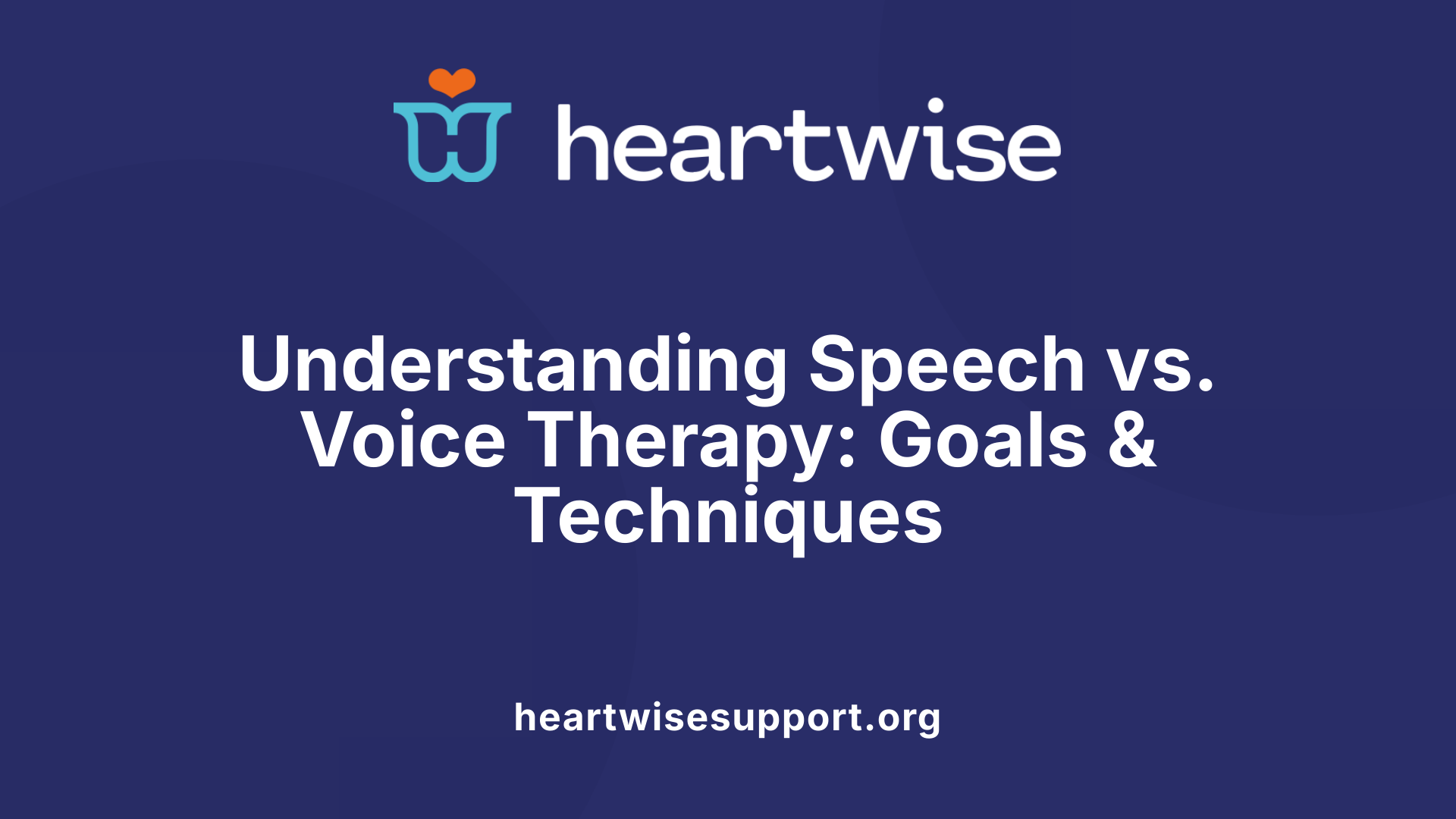Understanding the Importance of Voice Care and Therapy
Vocal health is essential for effective communication, whether for professional singing, public speaking, or everyday conversation. Speech therapy plays a pivotal role in diagnosing, treating, and rehabilitating voice disorders, helping individuals restore and optimize their vocal quality. This article explores the intricacies of speech and voice therapy, the methods employed, and how tailored interventions can significantly improve vocal function.
The Scope and Focus of Speech vs. Voice Therapy

What is the difference between speech therapy and voice therapy?
Speech therapy and voice therapy are related fields under the umbrella of speech-language pathology, but they serve distinct purposes and focus on different aspects of communication. Speech therapy primarily aims to improve overall communication skills such as articulation, language, fluency, and swallowing. It addresses a broad spectrum of speech and language disorders, including difficulties with pronunciation, stuttering, and comprehension.
In contrast, voice therapy concentrates specifically on issues related to vocal production. It works to optimize the health, quality, pitch, loudness, and efficiency of the voice. This includes treating conditions like vocal cord nodules, paralysis, muscle tension dysphonia, and overall vocal fatigue.
While many professionals are trained as speech-language pathologists capable of providing both types of therapy, some specialists focus solely on voice disorders, especially those of professional voice users such as singers and broadcasters. The techniques employed in each therapy reflect their goals: speech therapy may include articulation exercises, language drills, or cognitive-communication strategies, whereas voice therapy involves vocal exercises, breathing techniques, and vocal hygiene education.
Techniques and goals of both therapies
- Speech Therapy: The goals are to enhance speech clarity, language comprehension, cognitive-communication skills, and swallowing safety. Techniques include articulation exercises, language development activities, fluency shaping, and cognitive-linguistic training.
- Voice Therapy: The aim is to improve vocal quality by reducing strain, enhancing resonance, restoring vocal cord function, and preventing injury. Common techniques involve vocal function exercises, resonant voice training, diaphragmatic breathing, semi-occluded vocal tract exercises like straw phonation, and education on vocal hygiene.
Scope and focus of each therapy
- Speech Therapy: Has a broad scope, addressing disorders related to speech sounds, language (expression and comprehension), fluency, and swallowing. It often involves working with children, adults, and individuals recovering from neurological conditions.
- Voice Therapy: Has a specific focus on optimizing vocal health and function. It is crucial for those with voice disorders caused by misuse, overuse, injury, or medical conditions. It also encompasses therapy for singers and professional voice users aiming to prevent damage and improve performance.
Both therapies are essential components of comprehensive communication care but are tailored to meet the particular needs of each individual. They may overlap in some cases, for instance, when voice issues impact communication clarity, but their core focus remains distinct.
Assessment and Diagnosis of Voice Disorders
 Determining the cause and severity of voice disorders requires a comprehensive approach that combines various evaluation methods. Speech-language pathologists (SLPs) conduct thorough assessments to understand the underlying issues affecting voice quality. An initial step often involves a detailed clinical voice evaluation, during which the SLP observes the patient's vocal habits, pitch, loudness, and resonance.
Determining the cause and severity of voice disorders requires a comprehensive approach that combines various evaluation methods. Speech-language pathologists (SLPs) conduct thorough assessments to understand the underlying issues affecting voice quality. An initial step often involves a detailed clinical voice evaluation, during which the SLP observes the patient's vocal habits, pitch, loudness, and resonance.
Instrumental assessment methods provide valuable insights into voice function. Techniques such as laryngoscopy or videostroboscopy allow visual examination of the vocal cords, helping identify physical abnormalities like nodules, paralysis, or inflammation. Acoustic analysis measures voice parameters like frequency, intensity, and quality, offering objective data to guide diagnosis.
Diagnostic therapy procedures include tailored vocal exercises and behavioral strategies aimed at reducing strain and improving vocal efficiency. These therapies help clarify whether the disorder stems from muscle tension, misuse, neurological issues, or structural damage.
Accurately determining the cause and extent of a voice problem is vital for planning effective treatment. Early diagnosis, especially within the first four weeks of persistent dysphonia, can prevent long-term damage and facilitate better recovery outcomes. By combining clinical evaluations, instrumental assessments, and therapeutic trials, SLPs can develop a targeted treatment plan that addresses individual needs and promotes healthier voice production.
Methods and Techniques in Voice Therapy
Voice therapy encompasses a variety of methods and techniques designed to improve vocal function, reduce strain, and promote overall vocal health. Among these, vocal exercises such as Vocal Function Exercises (VFE) and semi-occluded vocal tract exercises like straw phonation, lip trills, and humming are fundamental. These exercises help strengthen and coordinate the vocal cords, enhancing efficiency and reducing fatigue.
Breathing techniques are also crucial components. Diaphragmatic breathing, which involves deep breathing using the diaphragm, supports better breath control and reduces tension in the vocal mechanism. Proper breath support is essential for maintaining vocal stability and preventing misuse.
Manual and relaxation techniques are employed to address muscular tension and improve voice quality. Manual therapy, including stretches and massage, can help release tension in laryngeal and neck muscles. Relaxation exercises, combined with postural adjustments, further facilitate efficient voice production and minimize strain.
Specialized approaches like the Accent Method and Lee Silverman Voice Treatment (LSVT) are also utilized. The Accent Method focuses on physiologic voice correction through targeted exercises, while LSVT aims to increase vocal loudness and clarity in patients with Parkinson’s disease. These approaches often incorporate exercises to optimize respiration, phonation, and resonance.
Overall, voice therapy adopts an evidence-based, multidisciplinary strategy. Techniques are tailored to individual needs, whether the goal is to rehab from injury, improve vocal endurance, or maintain healthy voice habits. Combining exercises, breathing support, manual therapy, and specialized approaches, speech-language pathologists work to restore and enhance vocal function effectively.
Types of Voice Disorders and Their Causes

What are the main types of voice disorders?
Voice disorders are generally classified into three categories: organic, functional, and psychogenic. Each type has distinct causes and mechanisms.
Organic disorders are caused by structural or neurological abnormalities within the voice-producing system. These include physical changes or damage to the vocal cords or related structures. Examples of organic issues are vocal nodules, polyps, cysts, and paralysis of the vocal cords, which may result from nerve injury or neurological conditions.
Functional disorders occur when the structure of the vocal cords appears normal, but their use is inefficient or strained. These are often related to habits or behaviors that affect voice production. Conditions like muscle tension dysphonia and hyperfunctioning of the vocal cords fall under this category. These disorders are often linked to voice misuse or overuse.
Psychogenic disorders are driven by psychological factors. These involve stress, emotional trauma, or conversion reactions that lead to altered voice use or production. Although less common, they can significantly impact vocal function.
Many voice problems involve overlapping causes or features, making diagnosis and treatment complex. Symptoms such as hoarseness, breathiness, vocal strain, and the sensation of a lump in the throat can be common across all types.
Examples of specific voice disorders:
| Disorder Name | Type | Description | Causes |
|---|---|---|---|
| Vocal Nodules | Organic | Growths on vocal cords caused by vocal trauma | Excessive talking, shouting |
| Polyps | Organic | Fluid-filled sacs on vocal cords | Vocal trauma, irregular voice use |
| Vocal Cord Paralysis | Organic | Loss of movement in vocal cords due to nerve damage | Surgery, neurological disease |
| Muscle Tension Dysphonia | Functional | Strained voice from excessive muscle tension | Stress, misuse |
| Hyperfunctional Voice | Functional | Overuse of vocal cords causing strain | Loud speaking, shouting |
| Psychogenic Voice Changes | Psychogenic | Voice changes due to emotional or psychological issues | Stress, trauma |
Understanding the causes helps clinicians develop targeted therapy plans. Voice disorders can be improved through various treatments, including voice therapy, medical interventions, and lifestyle changes.
More about types of voice disorders and causes
To explore further, search for 'types of voice disorders and causes' to access comprehensive information from trusted sources and stay updated in voice health knowledge.
Signs and Treatment of Voice Disorders

What signs indicate the need for voice therapy?
Recognizing when to seek help for a voice disorder is crucial. Common signs include persistent hoarseness, which may appear as a rough, raspy, or strained voice that does not improve over time. Vocal fatigue, such as feeling tired after speaking or singing, indicates that the voice is strained or not functioning efficiently.
Changes in pitch or loudness, including a deeper voice or difficulty reaching certain notes, are also warning signals. Individuals might notice their voice becoming weaker or losing clarity, especially after prolonged use.
Other symptoms include a sensation of rawness or a sore throat, frequent throat clearing, and a feeling of strain during speech or singing. If these symptoms are accompanied by difficulty speaking loudly or for extended periods, or a reduced vocal range, further assessment is recommended.
In many cases, voice problems arise from misuse, overuse, structural abnormalities, or neurological conditions. Voice therapy, delivered by a speech-language pathologist, can help address these issues. Early intervention is particularly important as it can prevent long-term damage, reduce the risk of developing more severe problems, and speed up recovery.
If you experience any of these signs consistently, consulting a qualified speech therapist is advisable. They can perform comprehensive evaluations and develop personalized treatment plans, which often include vocal exercises, hygiene education, and techniques to reduce strain and improve vocal efficiency.
Effective Exercises for Vocal Enhancement and Prevention

How can voice therapy exercises help with conditions like hoarseness and vocal weakness?
Voice therapy exercises play a vital role in improving issues like hoarseness and voice weakness. These exercises strengthen the muscles responsible for voice production and improve coordination among respiration, phonation, and resonance. Techniques such as Vocal Function Exercises, resonance exercises, and pitch glides promote healthier vocal cord movement and reduce muscle tension.
Practicing diaphragmatic and belly breathing, yawning, sighing, and relaxation helps minimize vocal strain and inflammation. Regular routines—often just a few minutes, twice daily—support the gradual restoration of normal voice quality, boost stamina, and prevent further damage. Overall, these exercises foster healthy vocal habits, enhance vocal cord healing, and sustain long-term vocal health.
Are there exercises suitable for self-guided practice at home?
Absolutely. Many effective voice exercises can be performed at home with proper guidance. Self-guided options include humming, lip trills, nasal consonant exercises, and chanting. These activities focus on resonance, breath support, and reducing strain.
For example, humming and lip trills encourage forward resonance and greater airflow control, making the voice sound clearer and more effortless. Nasal consonant exercises and simple vocal chants are also helpful, especially when combined with good vocal hygiene practices like staying hydrated and avoiding irritants.
It is essential to follow instructions from a speech-language pathologist initially to ensure proper technique. Consistency is crucial, and performing these exercises regularly helps improve vocal clarity, reduce fatigue, and support overall vocal health. When integrated into daily routines, these practices can be a powerful component of voice care and early intervention.
Maintaining Vocal Health for Long-Term Wellbeing
Vocal health is foundational to clear communication and overall quality of life. Through a combination of professional voice therapy, personalized exercises, lifestyle modifications, and ongoing vocal hygiene practices, individuals can significantly improve their vocal quality, recover from disorders, and maintain healthy voice use. Early intervention is key to preventing long-term damage, and ongoing education about vocal health ensures sustainable vocal well-being for both everyday speakers and professional voice users.
References
- Voice Disorders - ASHA
- Voice Therapy For Hoarseness: Learn How To Fix a Hoarse Voice
- Hoarse? Speech Therapy Can Help You Strengthen Your Voice
- How Speech Therapy Works: Improving Communication and Vocal ...
- Voice Therapy | Duke Health
- Voice Disorders - University of Nebraska Medical Center
- Voice Therapy: Techniques for Better Communication
- Taking Care of Your Voice - NIDCD.NIH.gov











